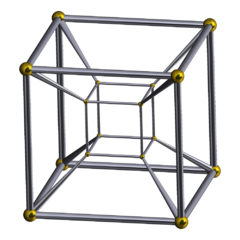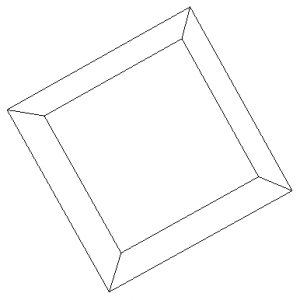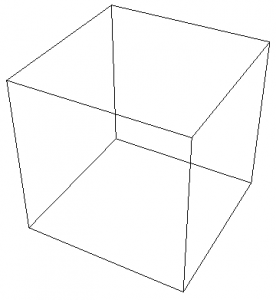How can you visualize a 4th spatial dimension? There has been much written and discussed on this topic; I won’t pretend that this post will compete with the vast resources available online. However, I do feel that I can contribute one small visualization trick for hypercubes that, for some reason, has not been emphasized very much elsewhere (although it is out there), which helped me get a foothold into the situation.
My first exposure as a kid to the topic of visualizing higher dimensions was given by Carl Sagan on the original Cosmos. In it, he introduces a hypercube called a tesseract:
While Cosmos is an inspirational introduction, it isn’t very complete. Still, there are many great resources on the web to help appreciate and understand the tesseract on many levels from rotations to inversions and beyond. They are part of a larger class of very cool objects known as polytopes. You are one google search away from vast resources on this topic. I won’t even bother compiling links.
What I hope to accomplish is to give you an intellectual foothold into the visualization, which will help considerably as you delve further into the topic.
Below is an image of a tesseract taken from the Wikipedia page on tesseracts

In what sense is this object a hypercube? Well, strictly speaking, this object is not a tesseract or hypercube. Technically, it is a two-dimensional projection (i.e. it is on this web page) of a three-dimensional shadow (the wire frame object if it were in 3D) of a 4D hypercube.
But how exactly can this object help us see into a 4th spatial dimension? Here is a visualization trick I’ve found most helpful for me:
Let’s start with something familiar. I can draw two parallelograms, one larger than the other, then connect the corresponding vertices. One’s mind will quickly interpret this as a cube as viewed from some angle, although it is just a two dimensional thing on a page. Your mind naturally views the (slightly) smaller parallelogram as being the same actual size as the larger one. It just looks smaller because we interpret it as farther away, thanks to perspective. Furthermore, all the angles, although drawn otherwise, are interpreted as right angles. The description makes it sound more complex than it is; it is just the representation of an ordinary cube viewed from some angle outside the page:
In the drawing, the parallelograms are almost the same size, so it is easy to flip back and forth between which one is the “front” face and which is the “back” face, generating weird distortions if it is viewed “incorrectly.”
Now, I rotate the cube so we are looking directly down one face. Think of this drawing as looking down a crude wirefame corridor:

However, on the page it is really just two nested squares with connected vertices. Still, one’s brain fills in the three dimensional details pretty naturally. Viewed this way, the smaller square is just further away and the angles are all right angles. If the smaller square were made smaller, even going to a point, you could imagine that the end of the corridor was just very far away.
The tesseract projection really is not really much different:
The visualization tool to remember is that the smaller cube only looks smaller because of perspective: the two cubes are actually the same size but the smaller cube only looks smaller because it is farther away. Further away in what direction? Into a 4th spatial dimension! When looking at the tesseract projection, think of it as looking “down” a kind of wireframe corridor directed such that the farthest point is actually at the mutual center of the cubes. This is the same sense that an ordinary long corridor drawn in two dimensions would have the far point (at infinity) located at the center of the squares. This mutual center is then interpreted as pointing in a direction not in ordinary three dimensional space; indeed, all six faces of the larger cube look “down” this corridor toward the other end. If you had such a hypercube in your living room, each of the six faces would act as a separate corridor directed towards the far point in a fourth spatial dimension. If your friend walked into the cube and continued down the corridor, they would not exit on the other side of the cube in your living room but rather would get smaller and smaller walking toward the center of the cube.
If you were the one doing the walking, it would be just like walking down a corridor into another room, albeit one that was entirely embedded — from all directions — within another one in three dimensions.
This is basically the idea behind Dr. Who’s tardis, as explained by the Doctor himself (although in his usual curt and opaque way):
You could think of the outer cube a crude 2 x 2 x 2 meter exterior to a tardis. The inner cube might be a 2 x 2 x 2 meter room inside the tardis (the same shape as the outside) 2 meters away into the 4th dimension. However, the tardis isn’t a mere hypercube. It has rooms inside that are bigger than the outside of the tardis. But to get them to fit inside the outer cube, you just put them farther away into the extra dimension. That is, you can visualize the inner cube as being a 100 x 100 x 100 meter room inside a 2 x 2 x 2 meter exterior box — except imagine you are 1000 meters away looking “down” the corridor of the 4th dimension, so the giant room looks small and thus fits fine into the exterior. This is exactly the point the Doctor is trying to make in the clip.
This idea was also a part of the plot of Stranger in a Strange Land by Heinlein. Valentine Michael Smith can make things vanish into a fourth dimension. The effect, as viewed by all observers in our own three dimensions, is to see the object get smaller and smaller from all angles until it vanishes. This is akin to walking down the corridor of the tesseract towards the center. The object appears to get smaller only because it is further away in this other direction outside of our usual three.
In my opinion, visualizing the tesseract as looking down a corridor into another spatial dimension with added perspective is the best first step in appreciating higher dimensional thinking. Here is a neat looking game that emphasizes the perspective approach and gives some practical practice with these ideas.
Update: Sean Carroll also just posted something on tesseracts on his blog Nov. 7.

